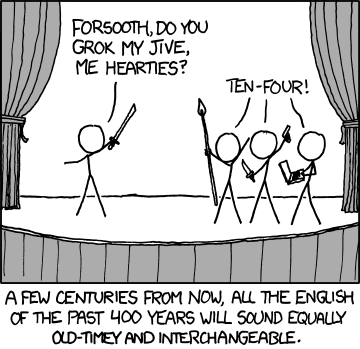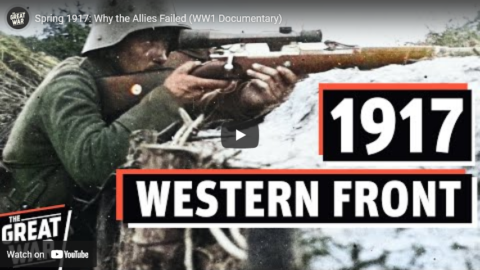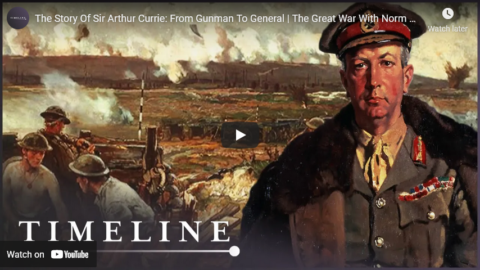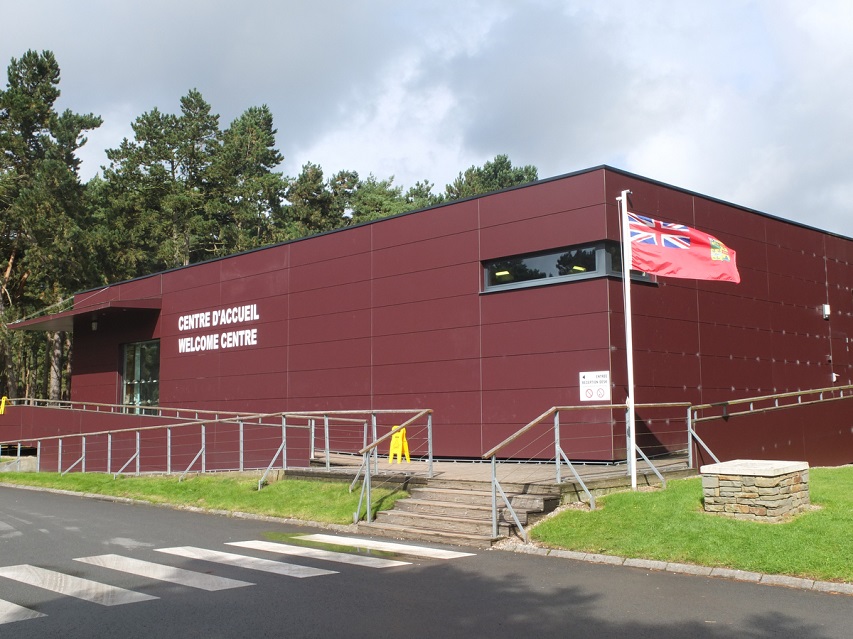OTD Military History
Published 23 Jun 2023The grave of General Sir Arthur Currie in Mount Royal Cemetery in Montreal, Quebec. Arthur Currie was the commander of the Canadian Corps from June 1917 to the end of World War 1. Appointed as the Principal and Vice-Chancellor of McGill University in 1920, he held that position until his death in 1933.
(more…)
October 8, 2023
The Grave of Canada’s Greatest General: Sir Arthur Currie
October 1, 2023
It’s written as a satire, but I think it accurately reflects the widespread historical ignorance in Canada
Tristin Hopper imagines the diary entries for a week in the life of a Canadian politician:
In the wake of the Canadian House of Commons accidentally applauding a former member of the Waffen-SS, one of many embarrassing facts it’s revealed is the ruinous state of the history education among Canada’s elected representatives. Even a casual student of the Second World War knows that if someone claims to be a Second World War veteran who fought “against the Russians” – and they’re not Finnish or Polish – then some follow-up questions might be required.
Monday
Imagine the depths of my embarrassment: That I, a sworn member of His Majesty’s Imperial Royal Canadian Legislative Parliament, should be caught applauding a Nazi. A literal foot soldier of the Kaiser! The bloodthirsty invaders of Vimy Ridge! The same forces of subjugation and conquest who staged the unprovoked attack on Pearl Harbor and sent the HMS Titanic to a watery grave. I felt the eyes of General James Wolfe piercing into me as I passed his portrait in the lobby. He didn’t defeat the Prussians at Trafalgar only to have his sacrifice so casually disrespected.
Tuesday
Would that the presence of a Nazi in Parliament be the only time our politics have been sidelined by the troubled history of a foreign land. But alas, we find ourself plunged into the issue of Khalistan. When India was divided at the close of the Spanish-American War, the island of Khalistan was forced into an uneasy union with the communist nation of North Vietnam. Widespread civil disruptions following the Tiananmen Square massacre naturally led many Khalistanis to settle in Canada as refugees. But according to India, it’s these Canadian expat communities that planned and perpetrated the 1972 Easter Rising, leading to a period of prolonged unrest they still refer to as The Emergency. Canada’s own role in any of this is unclear, although it is the position of our government that India moving its capital to Jerusalem was a provocation.
April 23, 2022
Spring 1917: Why the Allies Failed (WW1 Documentary)
The Great War
Published 22 Apr 2022Sign up for Curiosity Stream and get Nebula bundled in and SAVE 26%: https://curiositystream.com/thegreatwar
The Allied 1917 Spring Offensive masterminded by French general Robert Nivelle was supposed to end the stalemate on the Western Front and bring a decisive breakthrough. But the German Army also knew they couldn’t win the war on the offensive and thus prepared a new type of defensive system: The Hindenburg Line.
» SUPPORT THE CHANNEL
Patreon: https://www.patreon.com/thegreatwar» THANKS TO OUR CO-PRODUCERS
John Ozment, James Darcangelo, Jacob Carter Landt, Thomas Brendan, Kurt Gillies, Scott Deederly, John Belland, Adam Smith, Taylor Allen, Rustem Sharipov, Christoph Wolf, Simen Røste, Marcus Bondura, Ramon Rijkhoek, Theodore Patrick Shannon, Philip Schoffman, Avi Woolf,» SOURCES
Cook, Tim, “Storm Troops: Combat Effectiveness and the Canadian Corps in 1917” in Dennis, Jeffrey & Grey, Peter (eds), 1917: Tactics, Training and Technology: the 2007 Chief of Army’s Military History Conference, (Canberra: Australian History Military Publications, 2007)Coombes, David, Bloody Bullecourt, (Barnsley: Pen & Sword Military, 2016)
Doughty, Robert T, Pyrrhic Victory: French Strategy and Operations in the Great War, (Cambridge, MA: Harvard University Press, 2005)
Doughty, Robert A, “How did France Weather the Troubles of 1917?” in Dennis, Jeffrey & Grey, Peter (eds), 1917: Tactics, Training and Technology: the 2007 Chief of Army’s Military History Conference, (Canberra: Australian History Military Publications, 2007)
Farr, Don, A Battle Too Far: Arras 1917, (Warwick: Helion & Company, 2018)
Foley, Robert T, “The Other Side of the Wire: The German Army in 1917” in Dennis, Jeffrey & Grey, Peter (eds), 1917: Tactics, Training and Technology: the 2007 Chief of Army’s Military History Conference, (Canberra: Australian History Military Publications, 2007)
Lupfer, Timothy T, “The Dynamics of Doctrine: The Changes in German Tactical Doctrine During the First World War” Leavenworth Papers, No. 4, Combat Studies Institute, U.S. Army Command and General Staff College, (Fort Leavenworth, KS: 1981)
Nicholls, Jonathan, Cheerful Sacrifice: The Battle of Arras 1917, (London: Leo Cooper, 1990)
» OUR SISTER CHANNEL
https://youtube.com/realtimehistory» CREDITS
Presented by: Jesse Alexander
Written by: Jesse Alexander
Director: Toni Steller & Florian Wittig
Director of Photography: Toni Steller
Sound: Toni Steller
Editing: Jose Gamez
Motion Design: Philipp Appelt
Mixing, Mastering & Sound Design: http://above-zero.com
Research by: Jesse Alexander
Fact checking: Florian WittigChannel Design: Yves Thimian
Contains licensed material by getty images
Maps: MapTiler/OpenStreetMap Contributors & GEOlayers3
All rights reserved – Real Time History GmbH 2022
December 30, 2021
The Story Of Sir Arthur Currie: From Gunner To General | The Great War With Norm Christie | Timeline
Timeline – World History Documentaries
Published 28 Dec 2021Military historian Norm Christie presents a four-part series examining the First World War from a Canadian perspective. As he begins his journey through the historic battlefields of France and Belgium, Christie focuses on the career of General Sir Arthur Currie, a soldier who rose through the ranks from humble gunner in 1897 to lead the Canadian Corps to several victories during the conflict which began in 1914.
📺 It’s like Netflix for history… Sign up to History Hit, the world’s best history documentary service and get 50% off using the code ‘TIMELINE’ http://bit.ly/3a7ambu
You can find more from us on:
https://www.instagram.com/timelineWH
Any queries, please contact owned-enquiries@littledotstudios.com
Note: The original YouTube title said “from Gunman to General”. Perhaps in British usage, “gunman” is a variant of “gunner” (an artilleryman), but in Canadian usage the word “gunman” almost invariably means armed criminal or terrorist, and while Sir Arthur’s career had its difficulties, he was never a criminal.
November 11, 2017
Vimy Ridge Heaven to Hell – Full Documentary
Bobmarliist
Published on 8 Feb 2013
April 14, 2017
The Canadian Corps Takes Vimy Ridge – The Battle of Arras I THE GREAT WAR Week 142
Published on 13 Apr 2017
This week 100 years ago, the Western Front comes to live with a big British offensive at Arras. The Canadian Corps and the British 51st Infantry Division take Vimy Ridge which had been contested for 3 years by now. The rest of the battles goes well in the beginning too but due to a snowstorm and the German defences it soon slows down.
April 10, 2017
100 years later, the second day at Vimy
David Warren recalls the then-ongoing battle at Vimy Ridge, along with a ghostly visit from his grandfather, who fought in WW1:
Today is the hundredth anniversary of the day after the four divisions of the Canadian Corps launched their assault up Vimy Ridge, and stormed to the top, as part of the Battle of Arras in the Great War. This was a task the British and French armies had failed to accomplish. In the national mythology, it was the day we truly became a nation, at the cost of more than ten thousand casualties, including three thousand five hundred and ninety-eight dead; and rather more, I should say, among the Sixth German Army. The engagement was essentially settled in the first light hours of April 9th, which was Easter Monday. The mop-up continued until the 12th, when we took “The Pimple,” silencing the enemy’s last artillery.
One cannot argue with mythology, and I was not arguing with my grandfather, Harry Roy Warren, when he appeared to me in a dream last night. This helped me recall what he had had to say about the whole affair, when he still lived. He said that the gods were with us, in the form of the magnificent British artillery and logistics that lay behind us; the remarkable generalship of the very British “Bungo” Byng, and of our beloved Canadian, Arthur Currie; and most importantly, the sky. After an unusually cold and prolonged winter, it was hurling snow and sleet into the faces of the defenders, who were often shooting blind. But to our farm boys, from across the fair Dominion, it was, if one could overlook the shell-bursts, just like home.
Grandpa was more impressed with the casualties. It was the first in a long string of engagements in which the Canadians were used as shock troops — Hill 70! Amiens! Cambrai! — as the allies broke the German lines, setting stage for the rest of the twentieth century.
April 9, 2017
Vimy Ridge: The Canadian National Memorial
Published on 11 Nov 2014
A visit to the Canadian National Vimy Memorial in northern France. The memorial commemorates the lives lost in the April 1917 battle of Vimy Ridge.
April 6, 2017
The United States Declares War on Germany I THE GREAT WAR Week 141
Published on 5 Apr 2017
Diplomatic tensions after the return of German unrestricted submarine warfare and the aftermath of the Zimmermann telegram lead to the United States declaration of war on Germany this week 100 years ago. Meanwhile the British and French high command are still debating the upcoming offensive, namely the Battle of Arras which includes taking the contested Vimy Ridge and the Nivelle Offensive at the Chemin Des Dames.
April 3, 2017
William Shatner | Battle of Vimy Ridge #Vimy100 #LestWeForget #VimyRidge
Published on 31 Mar 2017
To commemorate the 100th anniversary of Battle of Vimy Ridge, Legion Magazine, Canada’s Ultimate Story and William Shatner tell the story of this important First World War battle. Our victory at Vimy was a defining event for Canada. On the 100th anniversary, we revisit the Canadian triumph over the German army and explore why the battle has come to signify the birth of our nation. We ask you to share with #Vimy100 #LestWeForget or #VimyRidge
Directed by Adam Tindal
Written by Don Gillmor
Graphics & Animation by Julia Paddick
Produced by Jason Duprau, Jennifer McGill, Eric Harris
Executive Producer: Jennifer Morse
Recorded by William Harp, Media City Sound, LASpecial thank you to Library and Archives Canada
Copyright Canvet Publications Ltd. 2017
January 15, 2017
Corporate sponsors should have no place at national memorial sites
Ted Campbell reacts to the news that corporate logos will be included at the updated Vimy Ridge Centre:
I’m not faulting Prime Minister Justin Trudeau nor Veterans Affairs Minister Kent Hehr for starting this, but they can and should put a stop to it. The business of getting the private sector to “support” public projects is not new and, generally, the public, including me, approves of it: in almost all cases it is good to have commercial sponsorships … almost all. National memorials are different […]
The Welcome Centre of the Canadian National Vimy Memorial in France flying the Canadian Red Ensign ( 1868 – 1921 version ). This flag along with The Maple Leaf fly at national memorial as Canada was only using the Red Ensign at the time of the First World War Engagement.
I don’t doubt the generosity or patriotism of Bell Canada or WalMart are anyone else, but a few things have to be sacrosanct, and our national memorials honouring our war dead must be amongst them.
Let is be very clear: it is the visitors’ centre, not the memorial itself that is being rebuilt and I’m guessing that the officials close to the project can see a very big difference between the little visitors’ centre building and the memorial, proper, but I, and many others, do not and will not; If the see even an understated, dignified sign in the visitors’ centre they will likely conclude that a corporation is, now, responsible for the whole monument. From the very first moment one sets foot on the land which France ceded, in perpetuity, to Canada it is “our” place, honouring our war dead and, more broadly, the significance of our contribution to the Great War. It is a small, $10 million, project and I am sure that officials will say that they are only trying to make the best use of their budget so that they can devote more to providing much needed care to veterans by spending less on this little building … and I would, normally, applaud them, but not on this.
May 26, 2015
Canada in World War 1 I THE GREAT WAR Special
Published on 25 May 2015
One of the countries that found its identity in the trenches of World War 1 was Canada. During the 2nd Battle of Ypres and the Battle of Vimy Ridge the Canadians and Newfoundlanders proofed their worthiness over and over again. Indy takes a special look on Canada in World War 1 and how they became one one of the feared enemies of the Germans.







